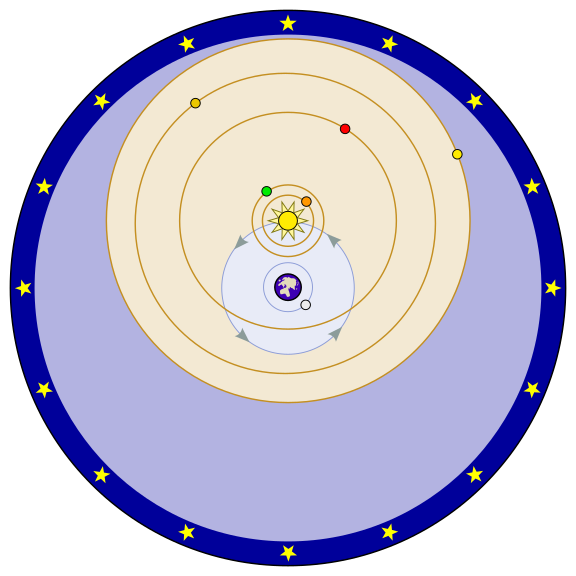But it is a thesis too radical for our times and one that no scientist is likely to feel the courage to entertain.
It is geostasis. In short, a stationary Earth or, at least, a revolving but not orbiting Earth.
Nuts? Well, maybe.
Yet this would most easily explain Airey’s failure, the Michelson result and the Sagnac result and would dispense with any need to posit a constant for the speed of light. Nor would it require any of the contradictions of SR and GR. Curved space-time reverts to the academic museum of curios from whence it ought never to have escaped.
One past astronomer of international fame, faithfully reproducing what he observed in the night sky, did produce a model of the solar system which accords completely with what is observed.
He was the famous Danish Astronomer and mentor of Johannes Kepler, his pupil, namely Tycho Brahe, later Astronomer-Imperial to the Holy Roman Emperor.
_-_Google_Art_Project.jpg) |
| Tycho Brahe was a Danish astronomer of Rennaissance times. His system - even today - accords most accurately with what you see in the night sky. |
Kepler inherited all Tycho’s calculations but later falsified them to fit his new-fangled ellipse theory.
Nevertheless, it is the Tychonian system which, even today, remains the most true to what is observed in the night sky. It explains, for instance, the apparent reversal of motion of Venus and Mercury which the Copernican system explains only by the use of epicycles.
There is a common misconception that the Copernican model did away with the need for epicycles. This is not true. The Copernican model could not explain all the details of planetary motion on the celestial sphere without epicycles. Indeed, the Copernican system required more than the Ptolemaic system. However, the Tychonian system requires none at all.
In the Tychonian system, the Moon and the Sun rotate around the Earth. Mercury, Venus, Mars, Jupiter, and Saturn rotate around the sun but the orbits of all save Mercury and Venus encompass also the Earth. Thus, from the perspective of the Earth, both Mercury and Venus appear, at one point in their sub-orbit round the Sun, to go into reverse as the Sun orbits the Earth.
But what of Stellar Parallax? This was the proof, surely, of heliocentrism?
Well, no.
Distance measurement by parallax is a special case of the principle of triangulation. The careful measurement of the length of one baseline can fix the scale of an entire triangulation network.
In parallax, the triangle is extremely long and narrow, and by measuring both its shortest side (the motion of the observer) and the small top angle (the other two being close to 90 degrees), the length of the long sides (in practice considered to be equal) can be determined.
Two different measurements are taken six months apart, to allow for the presumed 186 million miles that the earth travels in its alleged orbit during that time period, from one side of the sun to the other.
Parallax is the appearance that stars move in the sky in relation to each other, or in other words, more “distant” stars shift every six months in relation to nearby stars that are allegedly closer. This is put forth as the evidence that the earth revolves around the sun annually.
 |
| Stellar parallax proves only that either the Earth is moving with respect to the stars, or that the stars are moving with respect to the Earth. In other words, it simply does not resolve the issue. |
There is a problem however: most of the star data that is catalogued by NASA exhibits negative parallax, in other words, most of the stars do not shift in the direction they need them to in order to support the heliocentric model.
In fact, however, stellar parallax proves only that either the Earth is moving with respect to the stars, or that the stars are moving with respect to the Earth. In other words, it simply does not resolve the issue.
In reality, it may be that the relationship between Sun and Earth, governed by multi-body dynamics with gravitational forces interacting to produce regular movement, cannot be determined by those who inhabit one of the bodies, without some static background which, of course, does not exist.
This is perhaps the reason why the late Professor Fred Hoyle, another Astronomer-Royal, felt able to say that the heliocentric model is as good as any other but no better (The Intelligent Universe, page 17).

Sir Fred Hoyle, Astronomer-Royal, felt able to say that the heliocentric model is as good as any other but no better.
Science can hypothesize and demolish an hypothesis but science cannot dogmatize. Doubts remain about each of the planetary system hypotheses and they cannot be resolved by refernence to unscientific dogma.
In matters of science, where there is no room for dogma, no final “court” and no final magisterial authority, the received wisdom is even more vulnerable to disproof. Yet many hypotheses have been treated as a kind of Delphic Oracle above and beyond any kind of challenge.
The result is that the real truth, whatever it may be, about the motion of the planets will, for the time being, remain obscured by wholly inappropriate scientific dogma rather than real science.
A generation that slavishly follows the media and fashion is unlikely to see the point.
Perhaps, after all, that much-maligned philosopher, theologian and scientist, St Robert Bellarmine, has still much yet to teach us?
...













.jpg)


























_-002.jpg/220px-Circle_of_Anton_Raphael_Mengs,_Henry_Benedict_Maria_Clement_Stuart,_Cardinal_York_(ca_1750)_-002.jpg)



9 comments:
Tribunus,
Is there a way to email you? I have a couple of questions I'd like to ask related to this series of threads.
Thanks
Sadly not. But you can mark the questions "Not for publication" and I will answer them anonymously.
I've just read this article, and I'm not convinced. Simply put, the discovery of exo-planets (planets revolving around stars other than the sun) has been achieved by several methods, one of which is the radial shift method, whereby one observes the position of the parent star as it and the planet orbit around a common centre of mass. Another technique is to measure the doppler shift (how far it moves away from or towards Earth), and as such determine the present of a planet.
Both require the changes to be periodic, and in multi-planet systems (which have been observed), the star's movement is quite complicated. Thus, it is implicit that a heliocentric model is much closer to the truth than the theory proposed by Tycho Brahe (though you did read correctly when I said that the star orbits as well about a common centre of mass).
Consider it this way - you have two balls on a pole, and you seek to balance the two on a vertical stand. If they're the same size, the balance point is half way along the pole. When on is more massive than the other, the balance point is closer to the more massive ball. Imagine then, the larger ball to be a star, and the smaller one a planet, and that should explain your issues.
This means that the Earth pulls on the Sun, causing it to orbit a point about 450 km from the Sun's centre of mass (which, in astronomical terms, is nigh-undetectible).
I just feel that these points of physical evidence that point to the heliocentric model as a simplified (but not totally correct, like the Bohr atom and quantum mechanics) version of the truth have not been answered adequately.
As to the rest, I'll be honest with three words - I don't know. But I intend to earn my PhD finding out.
Otherwise, a fine blog.
Thank you for being honest enough to admit that there are parts you don’t know. That’s a good start for any scientist and very rare these days.
Belief in heliocentrism has now taken on a similar status as a religious dogma which is highly inappropriate for a scientific theory. There will always be ad hocs advanced to defend it and your two ad hocs are no different.
If you are determined to believe in this dogma, nothing either I or anyone else can say will change your mind. The same goes for those who are dogmatic about geocentrism, by the way. My point is that there is no room for dogma in science.
Radial shift. This proves no such thing.
Observing the position of the so-called “parent” star as it and the planet orbit around a common centre of mass does not prove heliocentrism. Where is the “common centre”? What are the star and planet moving relative to? Calling the star a “parent” is already a self-serving and circular argument.
The Doppler effect is no better a proof than stellar aberration.
Wavelength of the light that we receive from objects moving relative to us becomes a little shorter (bluer) when we approach the source and becomes longer (redder) when we move away from the source. But how do we know that we are moving rather than the source. Answer: we don’t.
The Doppler effect proves that Earth has a velocity relative to the stars, similar to aberration, but it only proves relative velocity i.e. the source could be moving and not the Earth.
Thus it simply does not prove heliocentrism and certainly does not prove it “closer to the truth than the theory proposed by Tycho Brahe” as you suggest.
In any case, you admit that the system is not sun-centred since you openly admit that you “said that the star orbits as well about a common centre of mass”. You thus admit that the sun is moving – bang goes your heliocentric dogma!
Your balls on a pole do not help us either. The fact that the balance point is closer to the bigger ball does not mean that the smaller ball is necessarily moving around it. You assume – by a circular argument - the very conclusion that you are seeking to prove and so beg the question.
You call this “physical evidence” when it is, in truth, no such thing.
But thank you, again, for your honesty.
I don't think I made it clear that I wasn't arguing for heliocentrism though in my previous post. Really, I'm trying to poke holes at Brahe's theory (the easiest way to prove something is to try and disprove it), and heliocentrism, like I said, isn't the truth (much like atoms as little billiard balls - they aren't, and I've studied Quantum mechanics at Uni and know the truth).
My question basically was this - could not Brahe's theory be simply due to our position as observers on Earth?
When you think about it, heliocentrism and Brahe's theory are basically the same theory, just keeping different points "stationary". Brahe demands that you hold Earth still (which, since we observe from it, is true relative to us). But what if you observed from Mars or Venus? Then wouldn't that planet get held still, while the others maintained their orbits around Sol?
So what if you observe from the Sun? The planets move about you.
In light of this, it is easy to see that heliocentrism and Brahe's theory share a common line of logic, and are based solely on observation points. Of course, the truth is neither is right (as I point out, much as the Sun pulls on us, we pull on the Sun, etc).
The balls on a pole is also not to prove heliocentrism. It was actually to illustrate the idea of centre of mass in a planetary system.
Basically, while heliocentrism isn't the truth when you really get down to the details, it generally doesn't matter in everyday life (much like the nitty gritty of Quantum Mechanics is also not of concern in a macroscopic world). Thus, like billiard ball atoms, heliocentrism is taught because it gives one a basic understanding of the solar system, and Brahe's theory is, as I have shown above, simply a logical derivative (or antecedant; either is accurate), with Earth, as our observation point, held stationary instead of the Sun.
Finally, I'd just like to dispell your perception of me as a dogmatist scientist. I am anything but. Science is provisional; you go with what you've got until you've got something better. I see the dogmatism that has overtaken much popular discourse in science (and believe me, I'm disgusted by it), but I know that only truth can ultimately matter in science, and my personal integrity obliges me to seek the truth, consensus be damned.
I know I'm a rare breed these days, but I exist. We're not all on that bandwagon.
Well you did say:
“Thus, it is implicit that a heliocentric model is much closer to the truth than the theory proposed by Tycho Brahe...”.
The fact that you are trying to “poke holes” in Tycho’s theory shows:
(a) That the theory is worth taking seriously; and
(b) That you still prefer heliocentrism or something approaching it.
The point of my post was to remind scientists that they are in no position to make statements like this: “I've studied Quantum mechanics at Uni and know the truth”.
The fact that you know the latest theory does not mean you know the truth. Weak scientists like Richard Dawkins think that theory = truth and then they treat the theory as unchallengeable dogma which is the very negation of physical science.
But you are surely right to ask “could not Brahe's theory be simply due to our position as observers on Earth?”.
Yes, it could.
But then so could heliocentrism.
Thus heliocentrism has no more claim to be held dogmatically true than any other theory. That was precisely why I quoted Fred Hoyle in The Intelligent Universe as saying heliocentrism is as good a theory as any other but no better.
You are also surely right to say and ask “When you think about it, heliocentrism and Brahe's theory are basically the same theory, just keeping different points 'stationary'. Brahe demands that you hold Earth still (which, since we observe from it, is true relative to us). But what if you observed from Mars or Venus? Then wouldn't that planet get held still, while the others maintained their orbits around Sol?”.
Yes, again.
Likewise, if you observe from the Sun, the planets appear to move about you.
One might say that the heliocentrists “demand” that you hold the Sun still.
So obvious is this that one can only conclude that dogmatic heliocentrists are at best weak scientists and, at worst, dishonest.
Additionally, there is the work of men like Y P Varshni which shows the stars arranged in concentric clusters which centre on the Earth. Heliocentrists simply ignore this and other interesting work.
The “truth” in science is elusive and, as Popper taught us, can amount to not much more than the latest theory to survive challenge.
I would add that one may (unless mad or delusional) rely upon one’s own observation. That is how courts of law operate: observation, the chain of testimony or evidence and the inductive method – same as science.
Science is rarely pure deduction. That is more the province of logic and philosophy.
What, however, you overlook is that the Tychonian view is not merely a mirror image of the Copernican. It differs in other ways. And, most importantly, it eliminates epicycles and accords with what we see in the night sky. The Copernican system does not so accord without a great many epicycles – even more than the Ptolemaic system.
That is a fact which scares the pants off heliocentrists.
And you now admit that your balls on a pole analogy was to prove some other, extraneous point, not that heliocentrism is better than Tychonianism.
I do not agree that “like billiard ball atoms, heliocentrism is taught because it gives one a basic understanding of the solar system”.
It is only partly that. It is also taught as a dogma so that it can be used as a weapon against the Catholic Church for daring to question the heliocentric dogma when it was promoted by Galileo and so as to attack that Church.
However, I salute you for saying “I know that only truth can ultimately matter in science, and my personal integrity obliges me to seek the truth, consensus be damned".
But I fear that you will sooner or later run up against the brick wall of the modern scientific dogmatists. They will not let you search for the truth and will mark you down and even sack you for it.
I am perfectly serious about that.
So be sure to duck and weave with subtlety and care.
I am afraid that you misunderstood my statement I studied QM at Uni and know the truth. I actually meant the "truth" that billiard balls weren't very accurate, and didn't match the observations (didn't I also say science was provisional?).
I am also under the impression that Galileo was not persecuted for advancing heliocentrism than his enemies construing his arguments as committing lese majeste against the Pontiff (who had, in point of fact, given Galileo express permission to discuss heliocentrism (though only as a theory; he violated that, but he might have gotten away with it, had his enemies in the Papal Court not been able to construe his words to be damning. And he was an abrasive man, who would have had many enemies). The Conflict Thesis itself is highly discredited amongst historians, since it was developed by two British historians at the end of the 19th Century so they could take a swipe at Rome (including such things as dodgy references, and only two examples - Galileo and Giordano Bruno - who were in point of fact persecuted for other reasons, and their scientific views being of little consequence in their trials).
Prof. Hoyle's quote had slipped my mind, but it is certainly accurate.
I will admit a preference for heliocentrism (since that is the preferred of science, as you have shown). But you've certainly made me think about things differently (the quirks of observation are very big in QM), which I'm sure is what you set out to do (and there's nothing wrong with that!).
Finally, I am an aspiring, but as yet unpublished author of science fiction. I hope to be able to make a living off that, and be able to be that old fashioned gentleman scientist who funds his own research.
That all sounds excellent - especially the last part! Good luck with it!
I read this today, 2022-03-23. Thank you. I came to it by way of interferometry.
Post a Comment